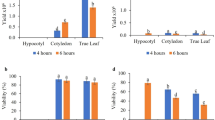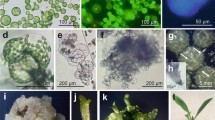Abstract
Round wormwood (Artemisia sphaerocephala Krasch) seeds were germinated on Murashige & Skoog (1962) medium without plant growth regulators. The hypocotyls of seedlings were sliced and cultured on M1 medium with 2,4-dichlorophenoxyacetic acid (9.05 μM) to induce callus. The induced calluses were subcultured on the same medium. Ten day old calluses were used to isolate protoplasts in an enzyme solution with 0.65 M mannitol. Protoplast yield strongly depended upon the state of callus cultures. Certain amount of hemicellulase could improve protoplast isolation. Purified protoplasts were cultured in modified Kao & Michayluk (1975) medium with 0.60 M mannitol as osmoticum, suggesting that protoplasts of A. sphaerocephala need a high initial osmolarity. Protoplasts generally divided evenly and the percentage of first division could reach 10%. Kinetin exhibited a positive effect on initial cell division. Furthermore, we studied the effect of protoplast density and vitamin C on sustained growth of protoplasts. After forty days, 1 mm calluses in diameter formed.
Similar content being viewed by others
Abbreviations
- CH:
-
casein hydrolysate
- 2,4-D:
-
2,4-dichlorophenoxyacetic acid
- KM8P:
-
Kao & Michayluk (1975) protoplast medium
- MS:
-
Murashige & Skoog (1962) medium
- MES-2:
-
(N-morpholino)ethanesulfonic acid
References
Al-Atabee JS & Power JB(1987) Plant regeneration from protoplasts of Dimorphotheca and Rudbeckia. Plant Cell Rep. 6: 414–416
Banks MS & Evans PK(1976) A comparison of the isolation and culture of mesophyll protoplasts from several Nicotiana species and their hybrids. Plant Sci. Lett. 7: 409–416
Barsby TL, Yarrow SA & Shepard JF(1986) A rapid and efficient alternative procedure for the regeneration of plants from hypocotyl protoplasts of Brassica napus. Plant Cell Rep. 5: 101–103
Berry SF, Lu DY, Pental D & Cocking EC (1982) Regeneration plants from protoplasts of Lactuca sativa L. Z. Pflanzenphysiol Bd 108s: 31–38
Binding H, Nehls R, Kock R & Finger J (1981) Comparative studies on protoplast regeneration in herbaceous species of the Dicotyledoneae class. Z. Pflanzenphysiol. Bd. 101s: 119–130
Kao Kn & Michayluk MR (1975) Nutritional requirements for growth of Vicia hajastana cells and protoplasts at a very low population density in liquid media. Planta 126(2): 105–110
Liu S-Q & Cai Q-Q (1990) Callus formation from protoplasts and plant regeneration from tissue culture of Silybum marianum Gaerth. Acta Botanica Sinica 32(1): 19–25
Murashige T & Skoog F (1962) A revised medium for rapid growth and bioassays with tobacco tissue culture. Physiol Plant. 15: 473–497
Nomura K, Fukuei K & Nitta T (1983) Culture of protoplasts isolated from somatic embryos of carrot. Plant Sci. Lett. 29: 1–7
Philippe L & Chupeau Y (1986) Isolation and culture of sunflower protoplasts: Factors influencing the viability of cell colonies derived from protoplasts. Plant Science 43: 69–75
Xu Z-Q & Jia J-F (1995) Tissue culture and plant regeneration in Artemisia sphaerocephala Krasch. Acta Bot. Boreali-Occident. Sin. 15(2): 100–103
Author information
Authors and Affiliations
Rights and permissions
About this article
Cite this article
Xu, ZQ., Jia, JF. Callus formation from protoplasts of Artemisia sphaerocephala Krasch and some factors influencing protoplast division. Plant Cell Tiss Organ Cult 44, 129–134 (1996). https://doi.org/10.1007/BF00048190
Received:
Accepted:
Issue Date:
DOI: https://doi.org/10.1007/BF00048190




